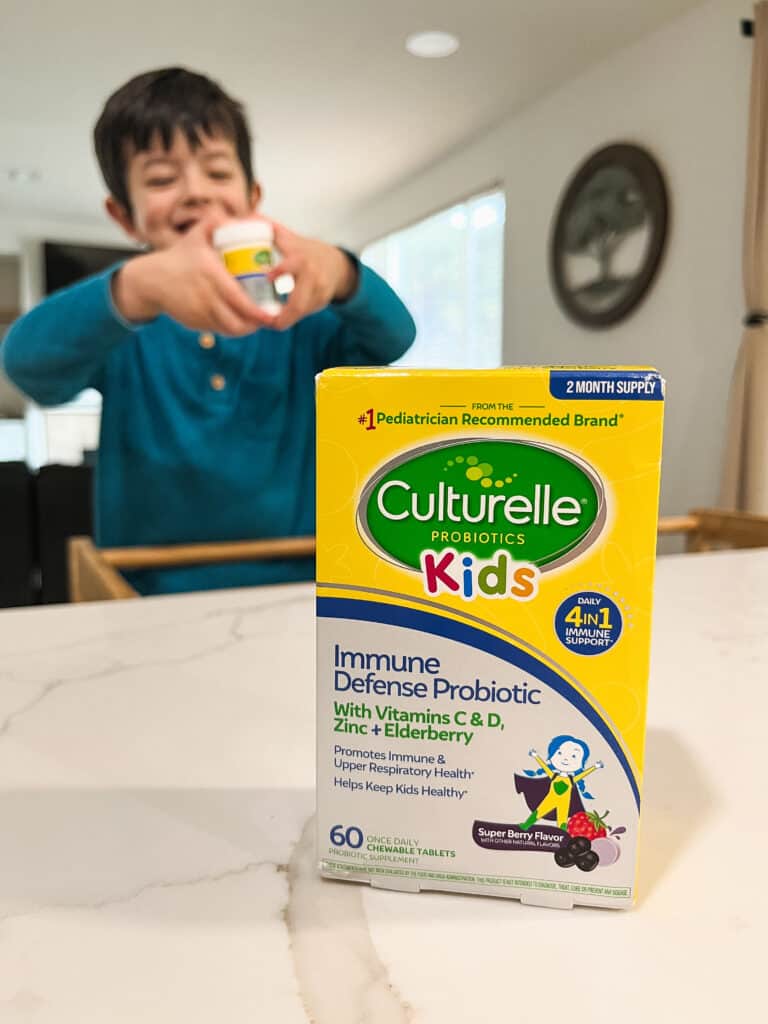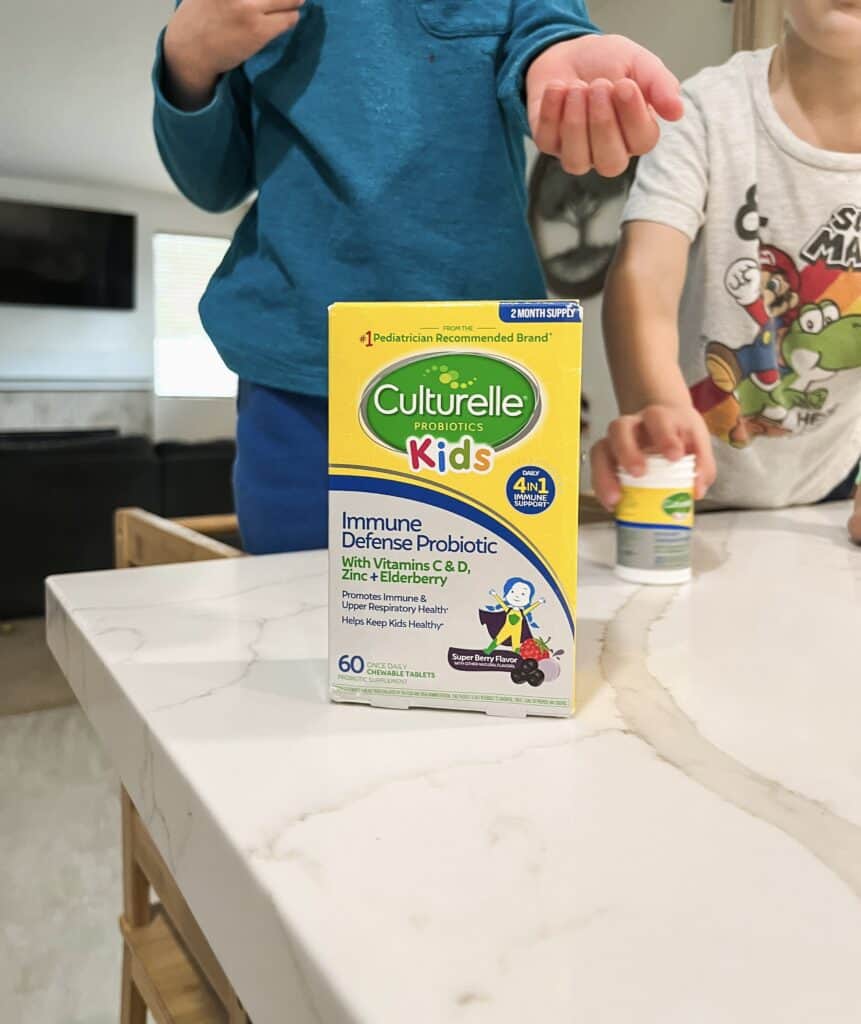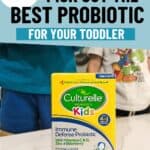Choosing The Best Probiotics For Toddlers — What To Know!
This post may contain affiliate links that I may receive a commission from if you click & buy. In addition, the information on this site is NOT intended to be medical advice. See my full policy for more information.
Looking for a probiotic for your toddler, but have no idea what to look for? It’s important to consider factors such as the type of probiotic, the number of live cultures, and the strains of bacteria. In this article, we’ll explain everything you need to know about narrowing down the best probiotics for toddlers. In addition, we’ll share our top toddler probiotic choices, types of probiotics, and key insights to consider.
For the longest time, I never used a probiotic. Not for myself, let alone, for my kids. Until one day I began dealing with digestion issues. My doctor ran some tests that came back normal and suggested I take a probiotic to support my gut health which would directly correlate to my digestive system. Sure enough, after about 2.5 weeks of taking one of the leading brands of probiotic supplements, I began to find my digestive system more normalized.
Fast forward to having kids, my youngest began having some digestive issues as an infant and one of the first things I asked his pediatrician was whether or not using children’s probiotics could help. They quickly informed me that “it couldn’t hurt, and typically has more benefits than not, so to give it a try”. Believe it or not, his symptoms began to improve weeks later.
Of course, overall health should always be the number one goal, but I’ve learned how important our gut flora and gut health is for our bodies — whether for adults or children. So, if you’re ready to introduce probiotics into your child’s daily life, let’s dig into all the details you’ll need to know first!

Don’t have time to read the full article? No problem! Grab our #1 favorite probiotic for toddlers: Culturelle® Kids Immune Defense Chewables!
This probiotic supplement for children works naturally with your child’s microbiome to promote immune and upper respiratory health*.
Understanding Probiotics for Toddlers
Probiotics are live bacteria and yeasts that are good for your child’s digestive system. They can help boost your child’s immune system, prevent diarrhea, and even improve their mood. How? They help maintain a healthy balance of bacteria in our digestive system, which supports our immune system and overall health. According to Healthline, probiotics can help reduce the risk of colic, improve dental health, reduce the severity of allergies, support the immune system, help manage inflammation, improve gut health, and benefit the nervous system.
Some of the most common probiotics for toddlers include Lactobacillus and Bifidobacterium. These two types of probiotics are naturally found in our gut and can also be found in some foods and supplements, such as yogurt, milk products, sourdough bread, and some kefir.
When Should Children Take Probiotics?
Probiotics can be helpful for children who do not consume a well-balanced nutritional diet (such as having a very picky eater), struggle with gastrointestinal issues such as diarrhea or constipation, or get frequent upset stomachs. The key is to talk with your child’s pediatrician to determine the best plan for introducing a probiotic to support their digestive health.
Another common reason it can be beneficial to give your toddler probiotics is if they’ve recently finished a course of antibiotics. Though antibiotics have a time and place to be taken to rid the body of harmful bacteria, it can sometimes rid your body if it’s healthy bacteria. This is where supplementing with a probiotic comes in helpful.
Be mindful that not all probiotics are the same (which we’ll cover more later in this article). Some probiotic supplements may have higher or lower CFUs, so it’s important to follow the specific dosage recommendations on the label.
Different types of probiotic strains and their benefits
Lactobacillus GG
- Lactobacillus GG is one of the most studied probiotic strains for toddlers. It has been shown to help reduce the incidence of infectious diarrhea in children. It also helps strengthen the immune system and improve gut health, especially in children with irritable bowel syndrome. You can find Lactobacillus GG in most probiotic products for toddlers due to its research-backed benefits.
Bifidobacterium Lactis
- Bifidobacterium Lactis is another probiotic strain that can have some health benefits for toddlers. It helps improve digestion and prevent constipation. It also helps boost the immune system and reduce inflammation. Bifidobacterium Lactis is another strain of probiotics commonly found in toddler probiotic supplements.
Saccharomyces Boulardii
- Saccharomyces Boulardii is a probiotic yeast that is great for toddlers who deal with frequent diarrhea. Some research shows “Saccharomyces boulardii showed significant improvement of the symptoms of diarrhea in children with acute gastroenteritis and reduced the duration of diarrhea symptoms and the time of hospitalization.” This probiotic yeast that promotes a healthy gut isn’t always in toddler probiotics, so keep an extra close eye out on the ingredients if it’s preferred.
When choosing a probiotic supplement for your toddler, it’s important to look for one that contains at least one of these strains mentioned above. You should also make sure that the supplement is specifically designed for toddlers or children and that it contains a sufficient amount of live cultures. As always, it’s best to consult with your pediatrician before giving your toddler any new supplements.
Practical Tips on Selecting the Best Probiotic Product
Probiotics can be given to toddlers in several different forms, such as powders, liquids, gummies, or chewable tablets. You can’t really go wrong with any of these options, but we will discuss their differences below to help you make the right choice for your toddler.
Choosing Between Chewable Tablets, Gummies, Powders, or Liquid drops
Chewable tablets are typically flavored tablets, easy for your toddler to chew before or after a meal. Chewable probiotics are a great option for toddlers who can chew their food thoroughly (usually around 3 years old +). They’re also travel-friendly if you’re planning to head out of town.
Powder probiotic packs are pretty versatile as they can be mixed with various foods or liquids, allowing for easier administration. Because of the powder formulation, dosing can be adjusted more precisely based on the recommended amount for your child’s weight and age. However, most probiotics that come in powder form come via single-serve packets.
Liquid probiotic drops are probably the easiest of all forms to administer. You can add the drops to food, drinks, or directly in their mouth. Though not the most travel-friendly due to the bottle they come in to ensure the stability of the product, many liquid probiotics are marketed to infants. Be sure to read the instructions on the bottle for age and weight specifications.
Gummy Probiotics are another great option for toddlers because who doesn’t love gummy vitamins? This form is often deliciously flavored, comes in cute shapes or characters, and lasts a while before expiring.
What’s the Best CFU Count?
The ideal CFU dosage for most probiotic supplements for toddlers is between 1-5 billion CFUs (colony-forming units) per day. For the most ideal amount for your toddler, check with your child’s pediatrician. CFUs are used to indicate the quantity of live and active bacteria present in a specific dose of the probiotic supplement. Remember, some probiotic supplements may have higher or lower CFUs, so it’s important to follow the specific dosage recommendations on the label for your toddler.
Best Probiotics for Toddlers (Top Probiotic Brands for Toddlers)
1. Culturelle® Kids
Culturelle® is a well-known, leading brand that makes probiotics for adults, kids, and babies! Their kid’s formulation contains 5 billion CFUs of the #1 clinically studied probiotic Lactobacillus rhamnosus GG†, to support digestive and immune health in children.* Their probiotics are also free from gluten, dairy, and soy, making them a great option for children with food allergies or sensitivities. It should be no surprise they’re our number one choice!

Another important factor that I personally love about Culturelle®, is that they measure the number of live probiotics at the product expiration date, guaranteeing you get the full amount per label whenever you purchase their product.
Their kid’s line of probiotics contains a variety of options from chewable to powder and probiotic gummies! However, our personal favorite is the Culturelle® Kids Immune Defense Chewable Probiotics!
- Culturelle® Kids Immune Defense Chewables: These are the probiotics I have used for my own kids for the last year and counting! My kids LOVE the fruity chewable flavor and ask for it every morning after breakfast. While my kids love the flavor, I love that it is formulated for both digestive AND immune support.* If we can support a healthy gut microbiome and immune system (especially with the preschool germs constantly going around), say no more!
2. NOW BerryDophilus Kids
Unlike the other probiotics on this list, NOW BerryDophilus Kids should be refrigerated to maintain potency and efficacy. These probiotics are another great tasty chewable option for toddlers 2 years + and are free of added sugars, but sweetened with xylitol.
They contain 2 billion CFUs of a 10-strain blend of probiotics.
Lastly, NOW BerryDophilus Kids is GMP quality assured, meaning that every aspect of the NOW manufacturing process has been examined, including their laboratory/testing methods for stability, potency, and product formulation.
3. LoveBug Kids Probiotics
Lovebug’s award-winning probiotics for kids come in a couple of different formulations: powder, gummies, easy-to-swallow pearls, and chewable tablets. This budget-friendly brand has incredible reviews online and offers a variety of products for toddlers and even infants. Best of all, their probiotics contain no added sugar, and are non-GMO, allergen-free, and refrigeration-free (meaning it doesn’t need to live in the refrigerator after opening).
Their chewable tablets contain 6 targeted probiotic strains with over 10 billion CFUs. The gummies contain 2.5 billion CFUs and are formulated to support your child’s digestive health and immune function. Their easy-to-swallow pearls contain 3 billion CFUs with 5 targeted strains of probiotics, formulated to balance good bacteria for proper digestion, immune function, and lifelong health.
4. Nordic Naturals Kids Probiotic Gummies
Nordic Naturals is another well-known, and respectable brand in the vitamin and supplement industry. In fact, transparency is a huge mission of Nordic Naturals. You can input ANY product lot number on their website to view a certificate of analysis of that specific product. Something I always look for when purchasing products like vitamins or probiotics for myself, let alone my kids.
Nordic Naturals Probiotic Gummies for Kids comes in a tasty berry flavor and contain 1.5 billion CFUs of probiotics per serving plus prebiotic fiber, including a potent probiotic Bacillus coagulans, to support your child’s digestive and immune health. These probiotics are also free from artificial colors, flavors, and preservatives.
If high quality backed by science is the kind of supplement you’re on the market for, Nordic Naturals is a great choice for you and your toddler.
5. Garden of Life Organic Kid’s Plus
Garden of Life Organic Kids+ Probiotics is a certified USDA organic, non-GMO, and vegan probiotic brand that is specifically formulated for children. They make shelf-stable and refrigeration-needed formulas and of course, contain plentiful beneficial bacteria. The chewable tablets contain 5 billion CFUs per serving with 14 probiotic strains, including Lactobacillus acidophilus and Bifidobacterium lactis. They also include Vitamins C & D and Prebiotic Fiber.
More good news about these probiotics is that they don’t contain any added sugars and come in a few different flavors, such as Organic Strawberry Banana and Organic Watermelon.
Selecting the right probiotics for toddlers to support their overall health and well-being can be so confusing with the huge variety of them widely available. After reading this article, you should have a better understanding of everything from which strain of bacteria to which brands of probiotics are the best options for your little ones.
And to reiterate one last time, be sure to always consult with your pediatrician about your child’s needs to help make finding the perfect probiotic for your toddler a no-brainer!
* These statements have not been evaluated by the Food and Drug Administration. These products are not intended to diagnose, treat, cure, or prevent any disease.
† Based on the number of Lactobacillus rhamnosus GG clinical studies, as of January 2022.



